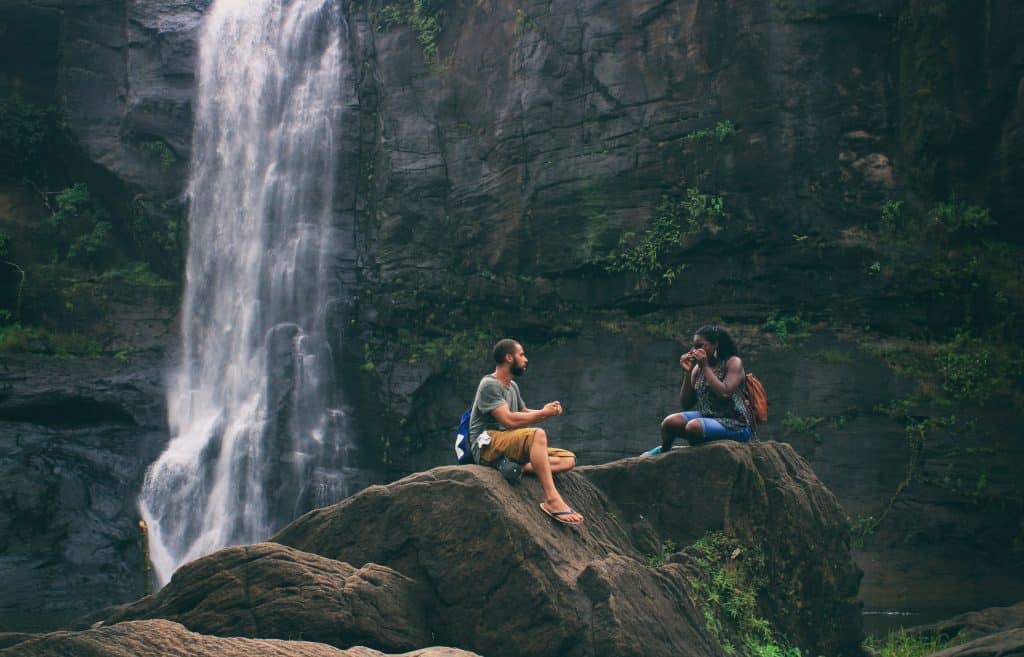When you’re out on the trail personal hygiene is normally the last thing on your mind. While backpacking through the woods you’re bound to go a few days without a shower. You need to take the good with the bad. To get those beautiful views you’ll have to make a few compromises.
That shouldn’t mean you have to throw all your hygiene out the door. Learning how to be comfortable with a little bit of dirt and grime is going to take a little time. You don’t need to sacrifice all the comforts of home just because your out in the woods.
Personal Hygiene Gear For Hiking
Personal hygiene out in the woods all comes down to common sense. You might not be able to bring all the comforts of home, but that doesn’t mean you should be disgusting. Just remember that all the gear you carry needs to be lightweight and easy to use.
Must Have Personal Hygiene Gear
- Gel Hand Sanitizer: Gel hand sanitizers with alcohol are a hikers best friend. You aren’t going to have easy access to water so you’ll have to use hand sanitizer frequently.
- Environmentally Safe Dish Soap: You can use dawn dish soap, but I would highly recommend environmentally friendly soap. A friend of mine gave me a bottle of Sierra Dawn Campsuds cleaner and I never turned back. The bottle is small, highly concentrated and is unscented so it won’t attract animals.
- Teeth Cleaning Products: Don’t forget your Toothbrush, toothpaste and dental floss. I’ve had more than one time that dental floss has fixed something in a pinch.
- Wash Cloth and Microfiber Pack Towel: You’re going to need some form of towel or wash cloth to clean up your dishes or bring along a cleaning brush.
- Toilet Paper and Female Hygiene Products: I shouldn’t need to tell you why you’re going to need toilet paper and feminine hygiene products. Most people prefer to bury their waste in a small 6 inch hole using a camp trowel. The Grizzly Peak Trowel even has a ruler in it to measure your poop hole. Keep in mind that some parks make you pack out all this nasty waste products so you might want to bring a plastic peanut butter jar or coffee can.
- Baby Wipes or Moist Towelettes: You aren’t going to have any way to wash your hands so bring along some baby wipes to clean up. Nobody wants to get poison ivy on their genitals, so wash your hands before and after using the bathroom.
- Deodorant (Optional): A lot of experienced hikers completely leave their deodorant at home, but they haven’t seen me after a week without deodorant. Supposedly deodorant can attract animals, but I’m willing to risk it.
Leave Some Gear at Home
- Razors: Let your beard grow and leave your razor and shaving cream at home. Water is hard to come by so you’re not going to be able to shave.
- Makeup: Hikers look better without all that makeup, maybe that’s just my opinion. Leave the makeup at home there’s nobody out in the woods to see you anyway.
- Mirrors: Just like with makeup you shouldn’t need a mirror out on the trail. If you throw a mirror into your backpack it’s bound to get broken.
- Wasteful Products: You’re going to have to pick and choose what kind of disposable products you bring camping. Everything you bring in needs to go back out.
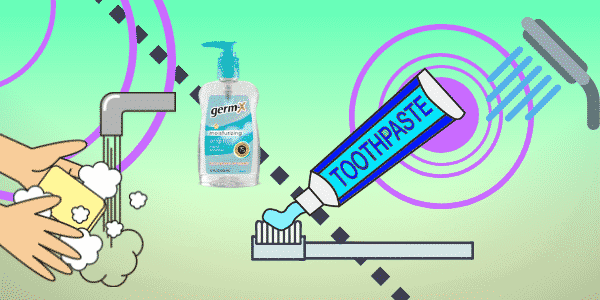
How Do I Shower While Backpacking and Camping?
Well the simple answer is that you don’t get to have a real shower, but that doesn’t mean you have an excuse to get scuzzy. You have hand sanitizer to clean your hands and baby wipes to clean up a bit, but that isn’t going to cut it. To get clean after a long sweaty day on the trail you’ll have to get creative.
- Trail Showers: Your best bet is going to be a simple trail shower. All you have to do is strip down and wash yourself with a washcloth and a couple buckets of water. If you’re a bit modest you can bring along a cheap WolfWise Pop-Up Shower Tent (bonus portable bathroom). If it’s a bit to chilly to take a real shower wipe down with wet wipes and a wash rag with heated water.
- Soak in The Lake or River: Most campgrounds and parks these days have some form of water feature that you can soak in. Flowing rivers are going to have the least amount of harmful bacteria.
- Drying Off: You need to bring along a lightweight microfiber towel to dry off. Microfiber absorbs moisture and dries quickly so it won’t weigh down your pack.
How To Stop Chafing
You’re going to be walking a lot so if you don’t properly prepare you’ll start chafing. With so much sweating and rubbing you’re going to have to clean up good.
- Use Wet Wipes: Wet wipes are going to be your best friend on the trail. Use wet wipes to clean up after doing your business to eliminate toilet paper residue.
- Squeeze Water Bottles: Squeeze water bottles eliminate the need for hand splashing on your nether regions. Properly cleaning your groin and surrounding skin will reduce the chance of chafing. It’s like a portable outdoor camping bidet.
- Switch Your Underwear: Bring one or two extra pairs of underwear that you can switch between. Wash your underwear everyday and hang them to dry. You can even flip them inside out if you’re really in a bind.
- Anti-Monkey Butt and Hike Goo: Bring along a little bit of Anti-Monkey Butt Powder and Hike Goo to prevent chafing. The Anti-Monkey Butt Reduces Moisture while the hike goo prevents rubbing.
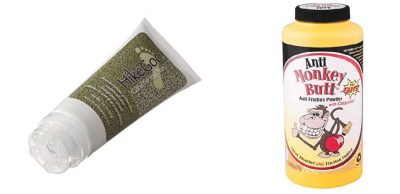
Cleaning Up With Hand Sanitizer
Without access to easy water you’ll have to use hand sanitizer to clean up. Hand sanitizer is going to have a million different uses on the trail. Use it when you go to the bathroom, before cooking, cleaning fish etc. If you don’t clean up all that nasty bacteria will end up on your food.
A lot of illnesses and stomach problems that happen on the trail are a direct result of hand to mouth bacteria. Don’t always blame bad water, with proper water filtration you’re drinking water should be perfectly safe. With alcohol based hand sanitizer you’ll kill all bacteria and germs.
Biodegradable Soap Saves The Environment
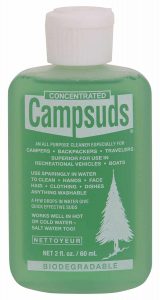 In the woods traditional soaps wreak havoc on the environment. Soaps like Sierra Dawn’s Campsuds are designed to be biodegradable and environmentally safe. You can use the Hisame soap for your laundry, dishes and even cleaning your hands and face.
In the woods traditional soaps wreak havoc on the environment. Soaps like Sierra Dawn’s Campsuds are designed to be biodegradable and environmentally safe. You can use the Hisame soap for your laundry, dishes and even cleaning your hands and face.
If you decide to use traditional soaps make sure you stay away from rivers and lakes. Soaps like dawn are known to cause severe algae blooms suffocating the fish population. Biodegradable soaps on the other hand break down into their base ingredients protecting the natural wild life.
Why do Some Hikers Skip Deodorant?
Hikers don’t leave their deodorant at home because they’re dirty hippies(well most don’t anyway). The reason hikers leave deodorant at home is because it tends to attract bugs and other wildlife.
Hiking experts across the board agree that deodorant will attract natural wildlife. The sweet smells of deodorant are known to attract bugs, raccoons and even bears. I know from personal experience that deodorant and tooth paste attracts raccoons. After a few days on the trail you’ll probably get used to your funky new smell.
Camping Bathroom Tips
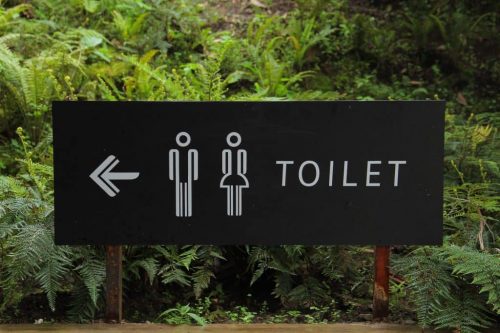
Pooping in the woods is no laughing matter, but it’s on everybody’s mind when they go into the woods. It’s crazy how few people actually know how to properly poop in the outdoors. Human waste can attract insects and animals if not properly dealt with. It needs to be properly buried and dealt with.
How To Poop in The Backcountry
Before you head out into the woods make sure you have all the supplies you’ll need to go number two. You’ll also need to learn a few techniques to properly poop in the woods.
Necessary Supplies:
- Sealable Plastic Bags: In a lot of different parks you’ll have to pack out your used toilet paper. That’s the best way to lower your environmental impact, but who wants to carry around a bag of shitty paper.
- Camp Trowel: You’ll need a basic camp trowel like the Grizzly Peak Backpacking Trowel. Use a lightweight trowel for digging a cat hole.
Where to Do Your Business
- Find a spot at least 200 feet away from both camp and your water source. Find a little bit of underbrush for some privacy on the trail.
- Look for loose soil and a sunny site that’s going to be easy to dig. Use a trowel or stick to dig a small 6-8 inch hole in the ground. About 4 inches wide should do just fine. If you cant find an area with soft ground look for a rock that you can move. The soil underneath rocks is normally moist and soft.
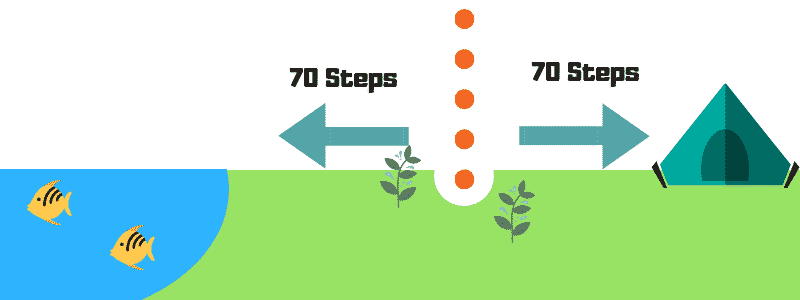
Choose Your Method
- Burial: In soil dig a hole 6 inches deep and 6 inches across. At the end of your business bury it with the dirt you remove.
- Packing It Out: There are quite a few parks throughout the country that make you pack out your waste. Use the same method you would use to clean up your dogs wast. Pick it up with a baggie and seal it into a large ziplock bag. Yosemite park suggest using a poo-tube made out of a 4 inch pvc pipe for easier transport.
Leaves vs Toilet Paper?
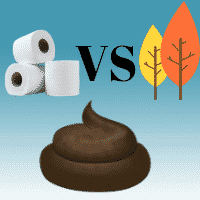 If you’re going to use leaves make sure you know what you’re doing. I would love to know exactly how many people have accidentally wiped with poison ivy or sap covered leaves. The main advantage of using leaves is you won’t be left with any toilet paper residue and you don’t have to pack them out.
If you’re going to use leaves make sure you know what you’re doing. I would love to know exactly how many people have accidentally wiped with poison ivy or sap covered leaves. The main advantage of using leaves is you won’t be left with any toilet paper residue and you don’t have to pack them out.
If you’re going to use toilet paper use as little as you possibly can. Make sure you know what you’re doing before you pop a squat. I would highly advise bringing along some wet wipes to clean up afterwords.
What if You Get a Period While Camping?
Most people are going to want to deal with a period the same way they would at home. Carrying around disposable products like tampons and pads is going to be your best bet. Just remember that you’ll have to pack out all the used products after you’re done.
If you’re looking for a more eco friendly option consider purchasing a silicone menstrual cup.
Caring For Your Hiking Clothes
Without running water caring for your clothing is going to be difficult out in the field. Certain fabrics are going to be a lot easier to care for than others. You’re going to want to stick to wools in the cold and moisture wicking fabrics in the summer. Anything that reduces your overall sweat is crucial while backpacking.
How Often to Change Your Clothes
If you do a little body cleaning and keep up your trail hygiene you shouldn’t have to carry lots of extra clothes. Most people are going to want to change out of their sweaty hiking clothes when they set up camp. When the sun starts to go down switch into warmer clothes and clean socks/underwear. At the very least switch into clean clothes before climbing into you sleeping bag unless you want to constantly clean it.
Unless you carry around a suitcase on longer 5+ day trips you can’t carry all the clothing that you’ll need. You’ll have to rotate your outfits or wash them in the field.
Washing Your Clothes While Camping
If you’re going to be on the trail for more than a couple days you’ll have to wash your clothes. All you’re going to need is a gallon ziplock bag and some biodegradable detergent. It’s surprisingly easy if you use the following method.
- Fill your bag halfway with warm water and a little bit of detergent.
- Add clothes to your gallon bag with a little bit of room to work it around. You need to have enough room to clean up your clothes by rubbing them around. The friction should work out most of the sweat and dirt.
- After you rub around the clothes shake around the bag without getting yourself wet. Shake it for 5-10 minutes and dispose of the dirty water.
- Refill the bag with clean water and rinse off your clothes.
- Wring them out and hang them up to dry.
Avoid Washing Your Clothes in The River
Unless you want to kill the local wildlife avoid washing your clothes with detergent in the river. It’s especially bad for the environment when the water is stagnant. Hop into the water without detergent if you’re really in a bind. As a bonus the water will clean off all the sweat and dirt.

